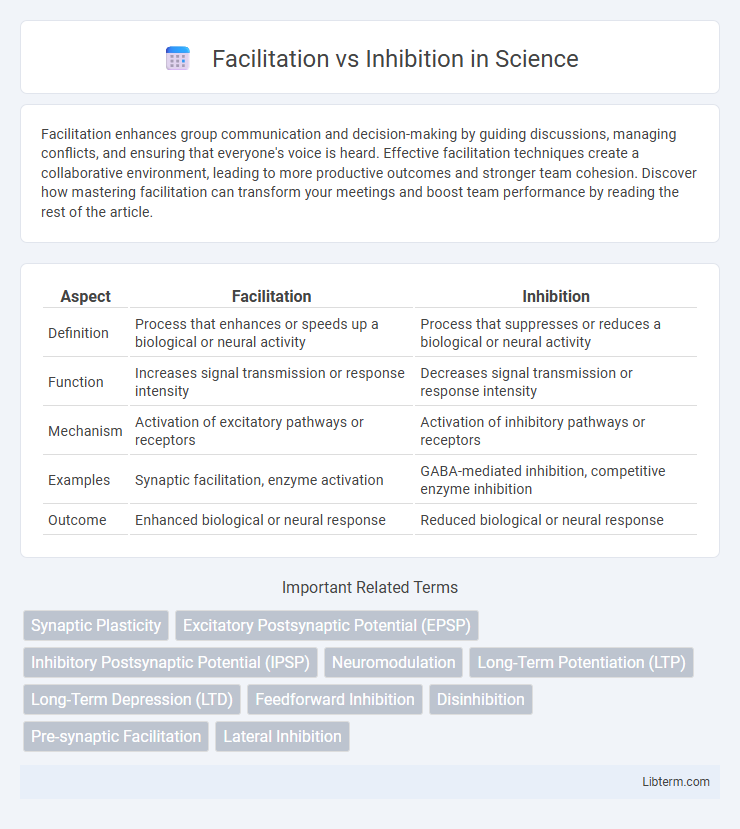Facilitation enhances group communication and decision-making by guiding discussions, managing conflicts, and ensuring that everyone's voice is heard. Effective facilitation techniques create a collaborative environment, leading to more productive outcomes and stronger team cohesion. Discover how mastering facilitation can transform your meetings and boost team performance by reading the rest of the article.
Table of Comparison
| Aspect | Facilitation | Inhibition |
|---|---|---|
| Definition | Process that enhances or speeds up a biological or neural activity | Process that suppresses or reduces a biological or neural activity |
| Function | Increases signal transmission or response intensity | Decreases signal transmission or response intensity |
| Mechanism | Activation of excitatory pathways or receptors | Activation of inhibitory pathways or receptors |
| Examples | Synaptic facilitation, enzyme activation | GABA-mediated inhibition, competitive enzyme inhibition |
| Outcome | Enhanced biological or neural response | Reduced biological or neural response |
Understanding Facilitation and Inhibition
Understanding facilitation involves recognizing how one neural process enhances the activity of another, increasing the likelihood of a response by amplifying synaptic inputs. Inhibition, in contrast, functions by suppressing neuronal activity through neurotransmitters such as GABA, reducing the probability of action potentials and maintaining neural circuit balance. The interplay between facilitation and inhibition is crucial for cognitive functions, sensory processing, and motor control.
Core Definitions and Key Differences
Facilitation refers to the process that enhances or accelerates a response or activity, often by increasing the excitability of neurons or the efficiency of synaptic transmission. Inhibition involves the suppression or decrease of neuronal activity, effectively reducing the likelihood of a response or controlling overactivity within neural circuits. The key difference lies in their opposing roles: facilitation promotes activation and signal propagation, while inhibition restricts or modulates that activity to maintain balance and prevent excessive excitation.
Mechanisms Underlying Facilitation
Mechanisms underlying facilitation involve synaptic processes such as increased neurotransmitter release due to residual calcium accumulation in presynaptic terminals, enhancing synaptic efficacy temporarily. Facilitation also depends on the modulation of ion channel activity that boosts postsynaptic excitability and signal transmission. These processes amplify neural communication efficiency by transiently increasing synaptic strength during rapid or repeated stimuli.
Mechanisms Underlying Inhibition
Inhibition mechanisms primarily involve GABAergic neurotransmission, where gamma-aminobutyric acid (GABA) binds to GABA_A and GABA_B receptors to reduce neuronal excitability. Postsynaptic inhibition occurs through hyperpolarization caused by increased chloride ion influx via GABA_A receptor activation, decreasing the likelihood of action potential generation. Presynaptic inhibition modulates neurotransmitter release by inhibiting calcium channel activity, thereby controlling synaptic transmission and neuronal network stability.
Facilitation in Biological Systems
Facilitation in biological systems enhances synaptic transmission by increasing the probability of neurotransmitter release during rapid successive stimuli, resulting in a temporary boost in signal strength. This process is primarily driven by residual calcium accumulation in the presynaptic terminal, which accelerates vesicle fusion and neurotransmitter availability. Facilitation plays a critical role in neural plasticity, supporting learning and memory by modulating synaptic efficiency and network excitability.
Inhibition in Biological Processes
Inhibition in biological processes plays a critical role in regulating cellular activities by suppressing enzyme function, neurotransmitter release, or gene expression to maintain homeostasis. Neural inhibition, primarily mediated by inhibitory neurotransmitters like GABA and glycine, ensures balanced synaptic transmission and prevents excessive neuronal excitation that could lead to disorders. Enzymatic inhibition, often achieved through competitive or non-competitive inhibitors, modulates metabolic pathways by decreasing the rate of biochemical reactions essential for proper cellular function.
Facilitation vs Inhibition in Neuroscience
Facilitation in neuroscience refers to the process where synaptic transmission is enhanced, increasing the likelihood of neuronal firing through mechanisms like residual calcium accumulation in presynaptic terminals. In contrast, inhibition involves the suppression of neuronal activity via inhibitory neurotransmitters such as GABA, which hyperpolarize postsynaptic membranes and reduce action potential generation. The balance between facilitation and inhibition is critical for neural circuit function, affecting everything from sensory processing to motor control and synaptic plasticity.
Real-World Applications of Facilitation
Facilitation enhances neural communication by increasing synaptic strength, playing a vital role in learning and memory processes essential for educational methodologies and rehabilitation therapies. In physical therapy, facilitation techniques improve motor function recovery by promoting plasticity in damaged neural pathways, accelerating patient progress. Cognitive training programs utilize facilitation principles to boost synaptic efficiency, aiding in the prevention and management of neurodegenerative diseases like Alzheimer's.
Practical Implications of Inhibition
Inhibition plays a critical role in cognitive control by enabling the suppression of irrelevant or distracting stimuli, which improves focus and decision-making efficiency. Practical applications include enhancing learning environments through targeted behavioral interventions and improving clinical treatments for disorders such as ADHD and anxiety, where inhibitory control is compromised. Strengthening inhibition mechanisms contributes to better self-regulation, impulse control, and overall mental resilience in everyday situations.
Comparing the Roles: Facilitation vs Inhibition
Facilitation enhances neural signaling by increasing the likelihood of neuron firing and amplifying synaptic transmission, thereby promoting faster and more efficient communication within neural circuits. Inhibition suppresses neural activity by decreasing neuron excitability and restricting signal propagation, crucial for preventing overstimulation and maintaining neural network stability. Comparing facilitation and inhibition highlights their complementary roles in balancing excitation and suppression for optimal brain function and adaptive behavioral responses.
Facilitation Infographic

 libterm.com
libterm.com